The TrimUI Model S is one of those handhelds that just appeared out of nowhere at the end of last year. Not much was known about the company behind it or the device itself. Now that it’s been available for a few months and the software has matured a little, let’s take a proper look at the little gadget.
Thank you to the Keep Game Store for sending me a unit for review.
SPECS
The TrimUI Model S belongs in the same family of handhelds as the Bittboy, PocketGo v1 and the PowKiddy V90. It’s powered by the AllWinner F1C200S SoC, which is the same family of ARM9 based chips found in those other machines. It’s at the lower end of the performance scale, sitting somewhere around the JZ4760 (LDK, RG300 etc) and RG350 series (JZ4770).
| CPU | AllWinner F1C200S |
| RAM | 64MB |
| Storage | Internal NAND / microSD |
| LCD | 2″ 320×240 IPS |
| Battery | 600mAh |
| WiFi / Bluetooth | No |
| Charging | USB-C |
| Headphones | No |
| Size | 106mm x 56mm x 9mm |
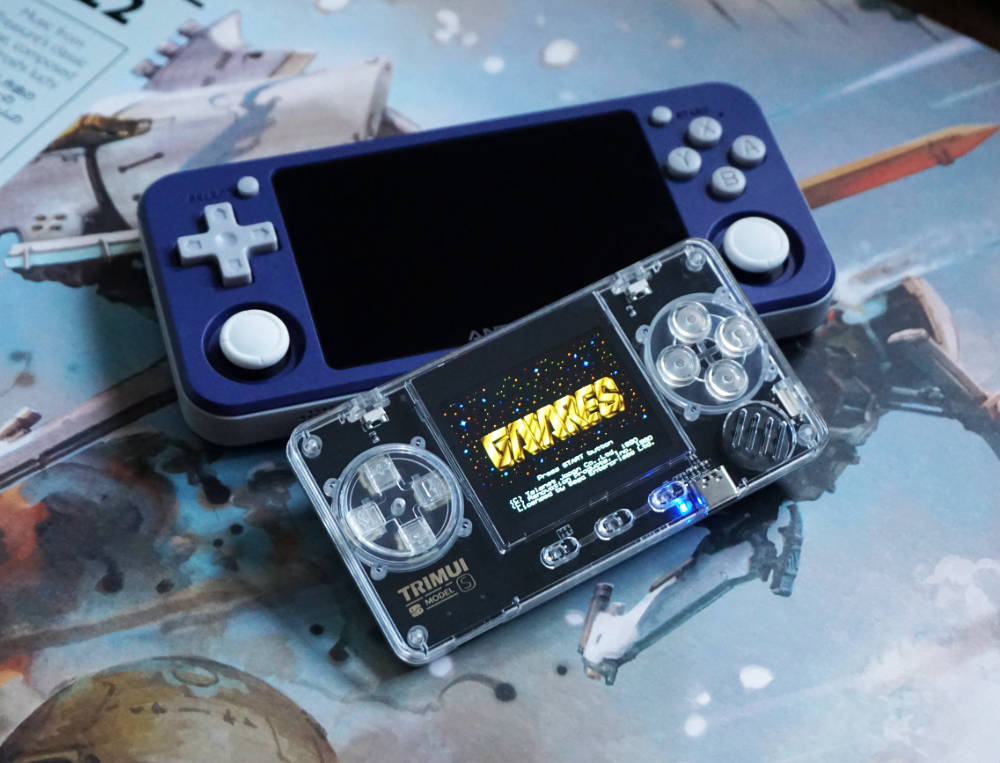
This level of hardware allows for decent SNES emulation with exceptions for games such as Yoshi’s Island in which I am only able to achieve 14 FPS. Many PS1 games run at an acceptable speed as long as you’re not too sensitive to frameskip. For most systems below these you’re good, and both GBA and Mega Drive are great on this hardware.
BUILD QUALITY AND CONTROLS
The TrimUI Model S is a small, slim and light little handheld that can happily be carried around in a pocket. The construction consists of a metal back plate (available in a few different colours) and a transparent plastic face plate that also serves as the lens for the LCD. For its size and weight, the construction and build quality is perfectly fine. Compared to other handhelds in the same category, the construction and plastics are much higher quality than those of the PowKiddy V90 and similar to the PocketGo V1. The entire device certainly has a kit feel about it. It reminds me of the first Odroid-Go in that regard, but that doesn’t detract from it at all in my eyes.
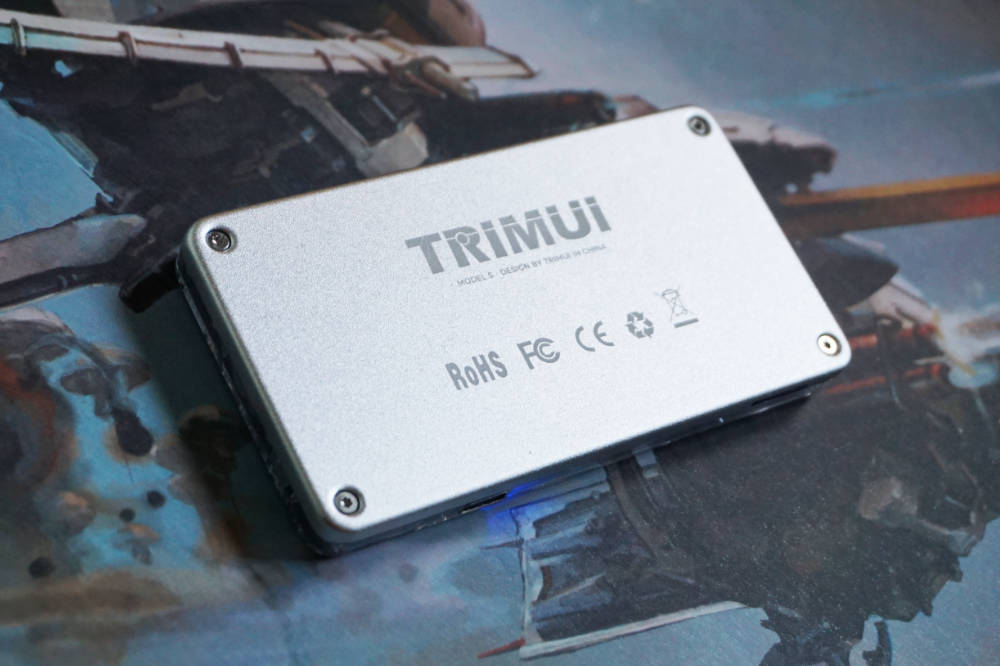
TrimUI seem to be a previously unknown brand related somehow to MacroKinetic, and who possibly don’t have prior experience designing handhelds. There are some strange design choices that I don’t recall seeing on any previous machines, namely in the way the d-pad and ABXY buttons are made. Instead of using conductive silicon pads to bridge contacts on the mainboard, both the d-pad and ABXY buttons are made up of clicky circular switches. Surprisingly though, this doesn’t actually make for bad controls at all. The d-pad itself is a circular drop in with a raised and textured cross piece, whereas the ABXY buttons are smooth, slightly domed and unlabelled.
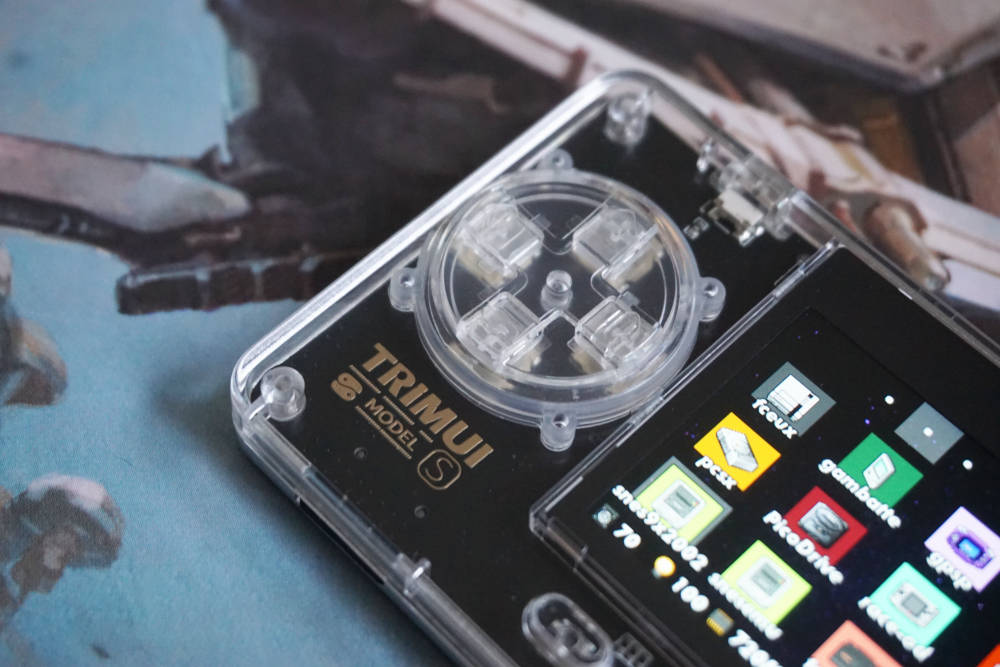
Because of the nature of switches, both sets of controls are rather loud and clicky. Personally I don’t mind the noise, and I actually quite like the tactile feedback that registers when each switch is clicked.
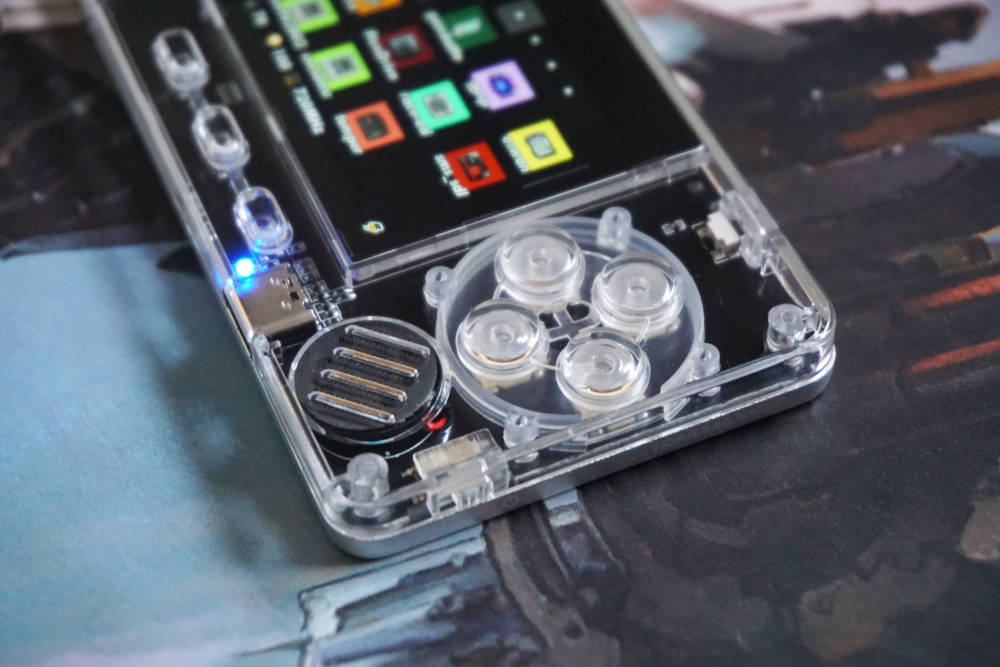
The shoulder buttons are small rectangles that sit roughly 1.5cm in from the edges of the shell. They only protrude a millimetre or so from the casing, and also click when pressed. On a device so small you might imagine they’re difficult to reach with larger hands, but because they’re set in from the edge of the shell they’re not actually that bad. It would have been better if they were bigger, but they’re serviceable.
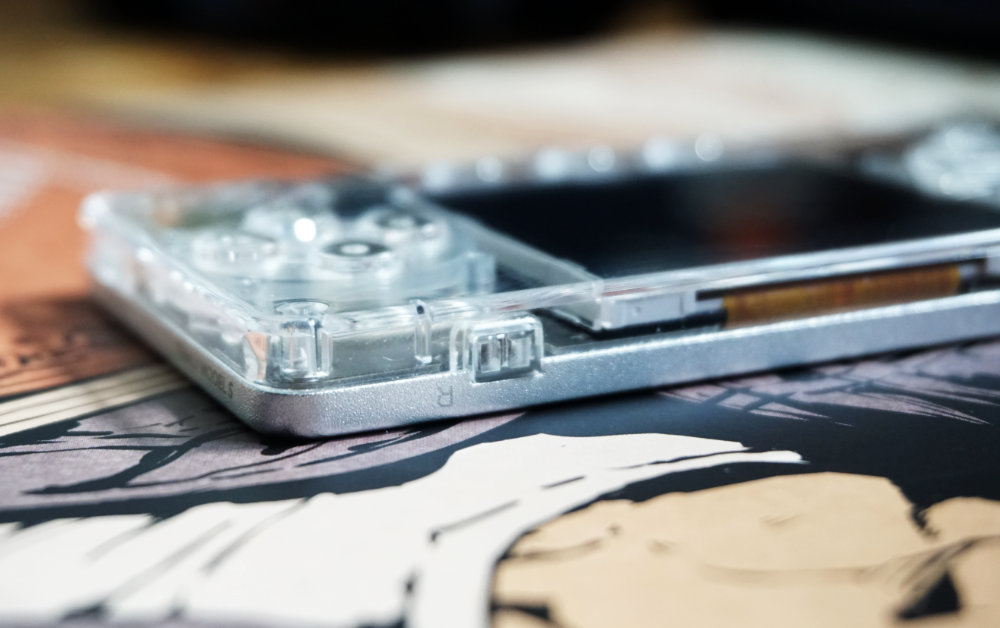
LCD
Given the overall size of this handheld it’s not surprising to discover that the LCD is also tiny. Measuring just 2 inches from corner to corner, it’s the same size as the one found in the GB Micro and also the RS-90 Retromini. Unlike both of those screens though, this one has a resolution of 320×240. That resolution plays nicely with a large selection of older systems, but for GBA you’ll have to use non-integer scaling for a full width image. On larger screens this makes for blurry pixels and whilst it’s noticeable on the Model S too, the small screen size definitely helps to reduce the blurriness a bit.
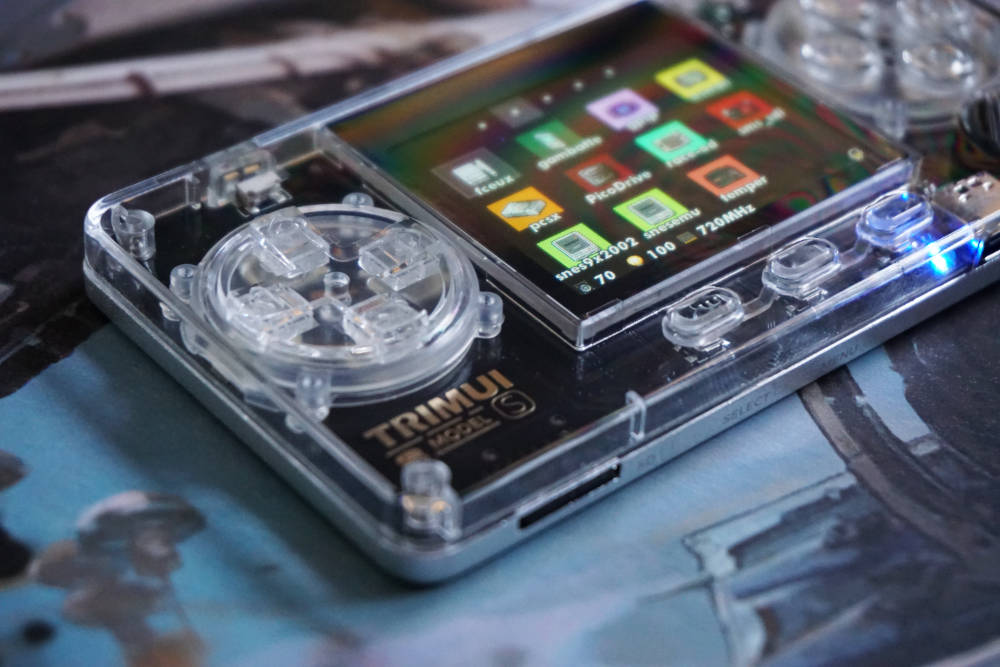
I do think though that they could have possibly squeezed in a slightly larger screen if they’d redesigned the shell a bit. The current LCD has a 3 or 4mm bezel around each edge, if they’d rejigged the design a bit they could have potentially got a borderless 2.4″ screen in there.
Don’t expect a laminated display on this thing either. As mentioned previously, the LCD screen lens is just made up of the clear plastic face plate that covers the whole of the front of the device. Visibility is fine and the IPS display itself is crisp and bright enough with no ghosting as far as I can tell. There is some light bleed from the top and sides which makes pure black appear grey in places, but it’s acceptable and not really noticeable most of the time. The original stock firmware does suffer from the same screen tearing effects as other AllWinner F1C series handhelds, but thankfully a firmware update from TrimUI and subsequent custom launchers has remedied this.
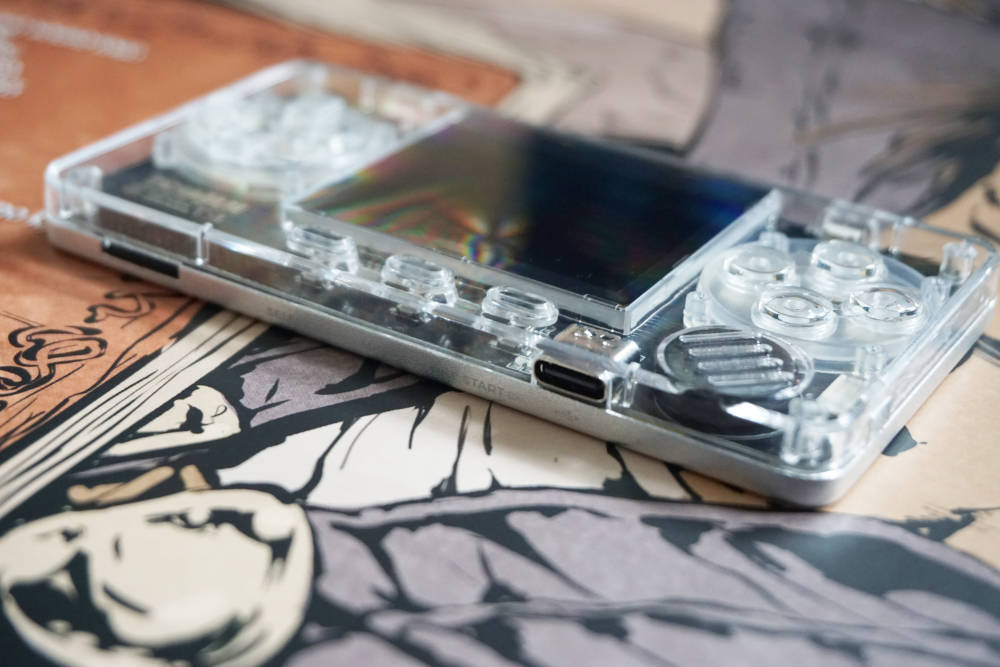
STOCK FIRMWARE
The way the Model S is setup is similar to PocketGo S30 in that the Linux portion of the OS is located on an internal NAND chip, rather than a microSD card. The microSD card itself is reserved for your choice of UI, emulators, games and ROMs. The stock UI is contained within the NAND, but it can be bypassed by loading either the GmenuNX or MinUI launchers to an SD card.
The first thing you should do is check which firmware version is currently flashed to the NAND. The latest version available from TrimUI is v0.105 as of today. In order to flash it you’ll need to head to the TrimUI site and follow the instructions under “Factory Recovery” and use the provided PhoenixSuit application to do it.

If the software doesn’t recognise that your device is connected and ready to be flashed, you will need to install the driver for it manually. To do this, open Device Manager on a Windows machine and look for the “Unknown Device” in the list. Right click, update driver and point Windows to the folder that you downloaded and unzipped from the TrimUI website.

Once the driver is installed, you should be able to flash v0.105 using PhoenixSuit and then install the newest firmware for it. From here you have three options. Option one is use the stock firmware, which works OK and has a clean, simple UI. If you like the simple theme but want to try out one of the custom front ends with support for more efficient emulators, take a look at MinUI.
MINUI
MinUI is the work of developer shauninman. It takes the stock front end aesthetic and cleans it up a bit, adds updated emulators and re-enables the settings menus for each emulator. Some useful features such as sleep (menu button in the main menu) have been added too. To a large extent the UI mirrors the file structure on the SD card, meaning that you can tailor and rename each system as you wish.
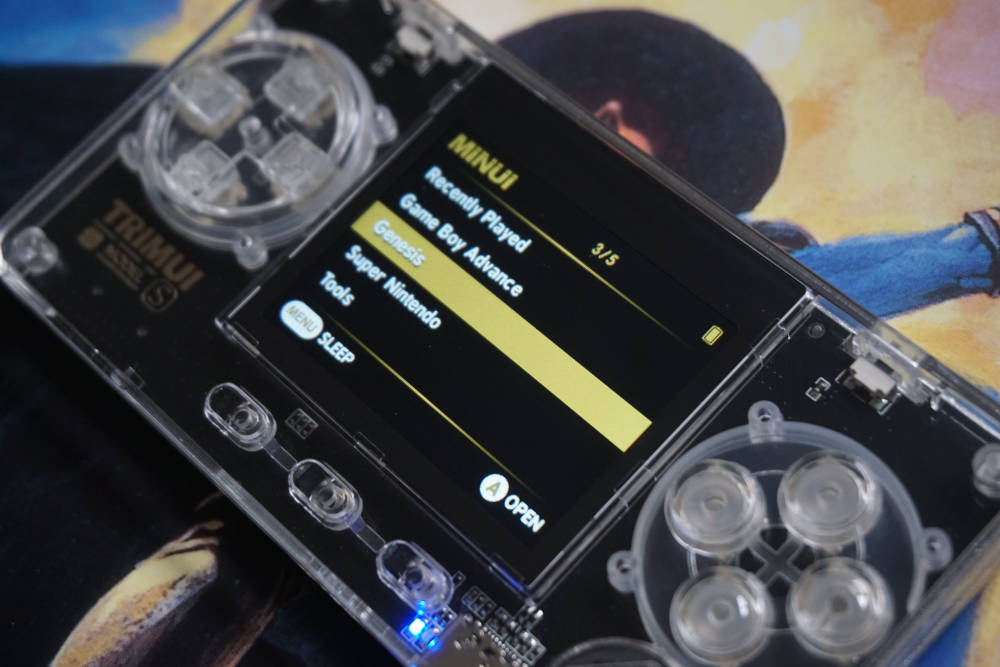
Systems are populated in the menu once you have added ROMs to each directory. You can swap back to the stock UI from MinUI at any time, and revert back again if you wish. Be aware that the stock UI uses different folder names for ROMs than MinUI. This is also the case in GmenuNX as GmenuNX uses standardised folder names for ROMs. This means that ROMs visible in stock and GmenuNX aren’t visible in MinUI as it is looking in a different location. It’s only really an issue if you plan to keep swapping between launchers. My advice would be to choose your favourite launcher and stick with it.

GMENUNX
This one might be familiar to more of you as it is available for the other AllWinner F1C series handhelds too. It offers a grid like menu system with a high level of customisation options available. Once installed you’ll see separate sections for new emulators and stock emulators and you can add and remove them as you see fit. There are currently 3 SNES emulators for this firmware, so perhaps choose your favourite and remove the others.
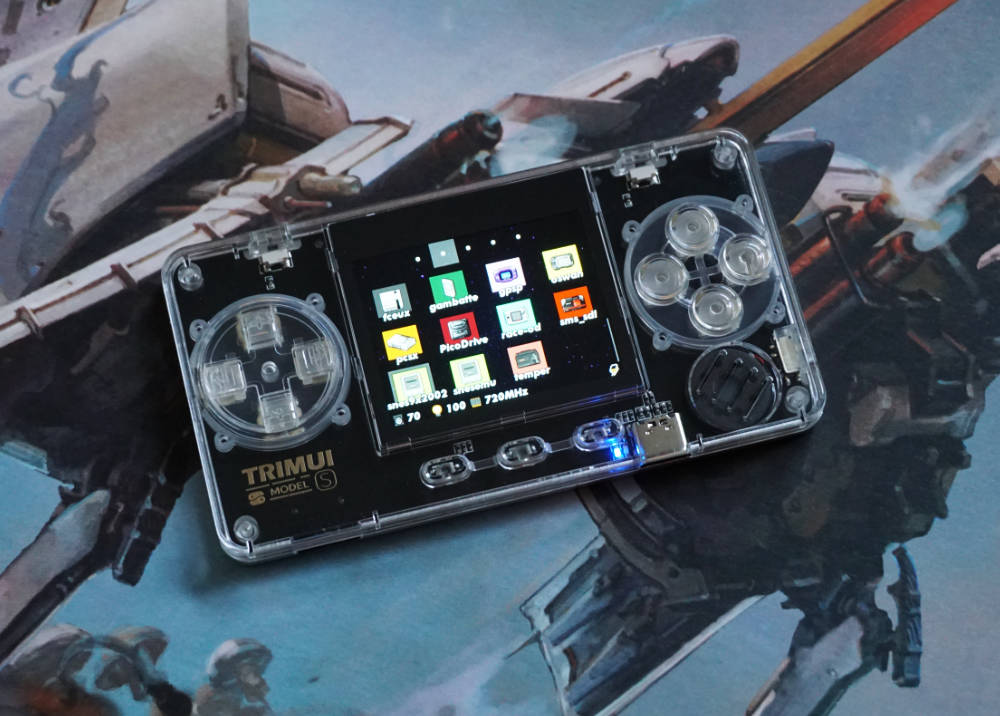
The developer eggs is responsible for bringing GmenuNX to the TrimUI Model S.
There is also a tool developed by eggs to flash a new boot-up logo to the NAND. You must make sure that the image you create is compatible, and I found the easiest way to create it was in GIMP. Your image must be encoded as below, and the export menu on Gimp allows you to choose the correct format.
- 320×240 resolution
- Saved as 16 bit bitmap (.bmp)
- Be less than 512k
- Be saved as R5 G6 B5
You can find the boot logo change script here. Simply give the image files and the script the same name, stick them both on your SD card and run the script from Commander.
You can use either of the scripts as far as I can tell (I’m not sure why there are two to be honest, they both do the same thing I think).
FINAL THOUGHTS
The TrimUI Model S is an interesting handheld and probably my favourite in this category. It’s very compact and portable and it has an interesting design style too. I am pleasantly surprised at how comfortable it is for my larger hands, and that’s definitely due in part to the shoulder buttons not being right at the edge of the shell. Given how thin the Model S is, it’s surprisingly sturdy. You’re not going to end up bending it if you carry it around in your pocket. I would perhaps suggest a screen protector if that’s your plan though, I’m not sure yet how resilient the plastic is.
My main gripes would be that the screen is just too small for many people. My eyesight is OK so 2″ is just about acceptable, but even a 2.4″ screen would have been noticeably easier on the eyes. The device lasts about 3 hours on a charge, which is OK but shorter than we are used to.
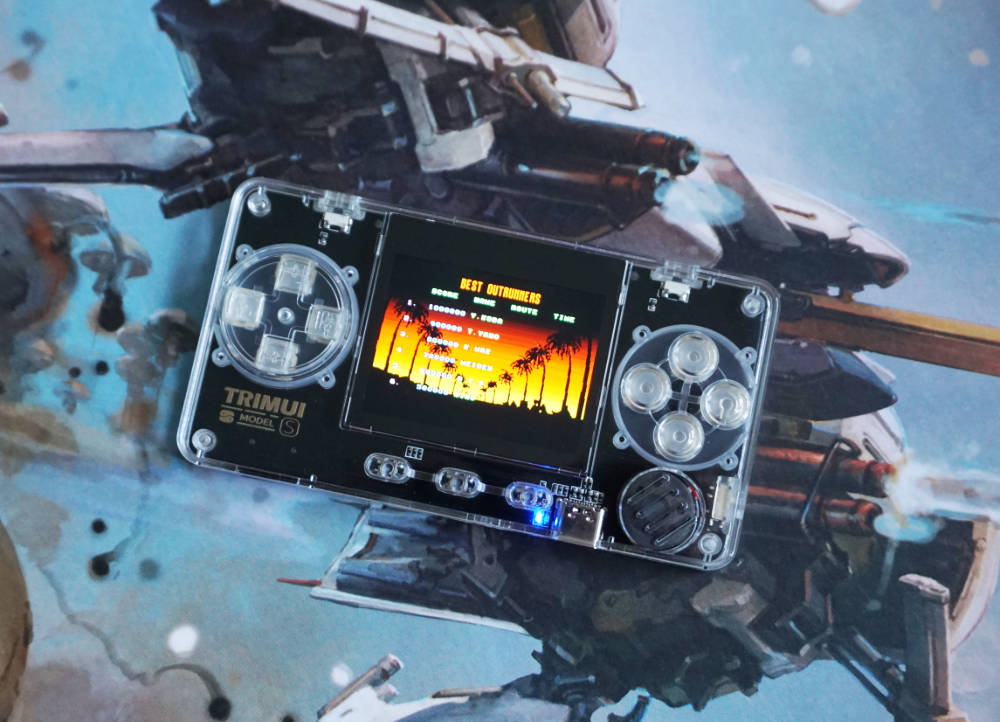
The TrimUI Model S comes at a difficult time for this type of handheld. Whilst it’s cheap enough to warrant its limitations, we’re at a stage where the emphasis is finally on more powerful devices. More power is the direction we should be headed, but with more power comes bigger handhelds and a higher cost. There’s still something to be said for neat little handhelds like these that can be tucked away in your pocket before heading out. Additionally, the development of MinUI brings an alternative launcher for those that don’t have time to tinker. It’s a neat and smart looking launcher that “just works” and will definitely find fans amongst the kind of people that just want to pick up and play.
Thanks to the folk at Keep Game Store for sending me over a unit to review. You can purchase this device from them on AliExpress, as well as various other stores. For the record, PowKiddy have also branded this handheld and have called it the PowKiddy A66. Affiliated links below.



i just bought this today, but i cant go to trimui website to upgrade mine to 0.105 (mine still 0.104). any chance that you still have the zip to update? thanks in advance
nice review thank you, I just got the powkiddy at 66, to update the emulators, are those of the PowKiddy V90 compatible?
I have a Trimui and I love it! Did the gmenunx cfw, how can I get these awesome skins? Thanks guys!
Does this have software or hardware shutdown? Probably a daft question, but if it had hardware shutdown it could be suitable for my youngest daughter.
Does it support boxart as opposed to screenshots shown in the review?
Thankfully it has hardware shutdown, you just turn the switch on and off, unlike the PocketGo v1 that needed to be shut down in software first before flipping the switch.
Excellent review! Shame the original TrimUI device is difficult / expensive to get hold of now that it’s been replaced by the PowKiddy A66.
I think some of the comments miss the point. This device isn’t to compete on power. There are plenty of other devices with bigger screens and capable of emulating newer systems. This device is so small that it can always be in your pocket ready for when you find a couple of minutes to yourself.
I own all the Nintendo handhelds (and a Vita!) but this is the device I play the most. It’s like the old adage about the best camera being the one you have with you.
I sold my gameboy micro a long time ago and always regretted it. Now this little handheld fills the void perfectly. I’ll get something else when I want to play higher end systems but as a Genesis/SNES/GBA machine it works great for me.
This system misses the mark across the board. The Pocket Go V1 is a much better option, typically 30-40% cheaper with mature support. I just don’t see the point in this device coming to market.
I had a PocketGo v1 and sold it because it was a glitchy mess with horrible screen tearing, mushy dpad, and a very cheap feeling. I just got my Powkiddy A66 yesterday, and it’s immediately more solid feeling and actually even a little smaller than the PG, and these clicky buttons and dpad are so surprisingly good I wish they were in more devices. As for price difference, the PG goes for like $30 and this goes for $40… for the upgrade in build quality and better controls, I think that alone is worth it. I love this thing so much that I’m going to sell my RG280v.
Just to correct you that eggs is not gameblabla, although he did use some of my forks and emulators (such as my fork of Temper and oswan) and he does sometime asks me questions about it but i have no direct involvement with it and would rather not touch this handheld given the poor specs. (the Bittboy and its F1C100S still gives me nightmares, the F1C200S is the same except for double the RAM)
Cheers
Apologies for that, I’ve corrected the info now.
“More power is the direction we should be headed”
This is true!
Ah well, maybe it will come one day.
I have never handled a CM4 even though I always say I want a CM4 handheld 😛 what Im trying to say is, I don’t know how that would work with its heat vs these other lower end chips we see in handhelds. Though I saw the CM4 adapter for the GPi case, and it looks like it fits in a REALLY closed space!